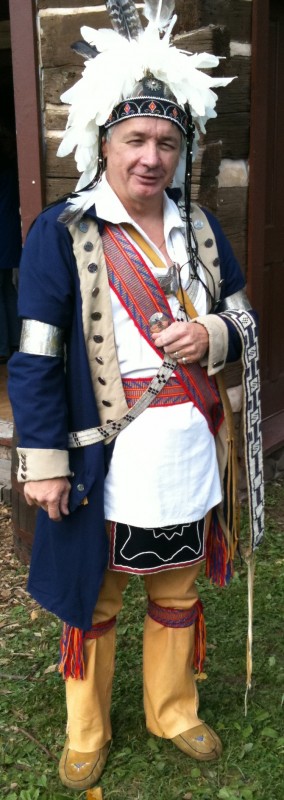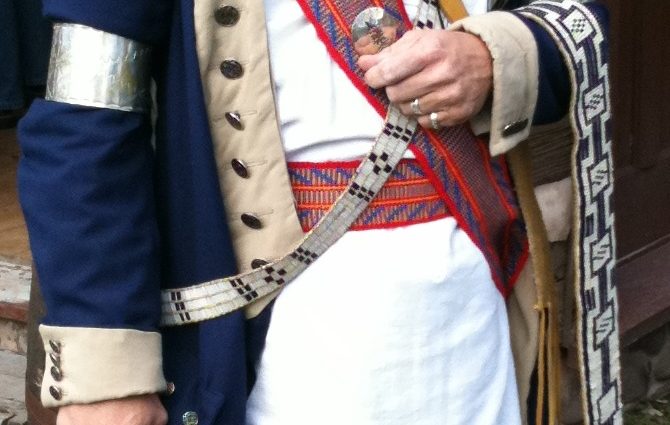 CFN – Iroquois on both sides of the Canada-US border were drawn into the War of 1812; for those mostly Mohawks who fought alongside the Canadian and British forces it was a matter of survival for they had good reason to suspect the expansionist Americans while their relatives to the south (mostly Seneca) elected to wage war out of fear that a position of neutrality would give cause by the US to remove them entirely from their shrinking land holdings.
CFN – Iroquois on both sides of the Canada-US border were drawn into the War of 1812; for those mostly Mohawks who fought alongside the Canadian and British forces it was a matter of survival for they had good reason to suspect the expansionist Americans while their relatives to the south (mostly Seneca) elected to wage war out of fear that a position of neutrality would give cause by the US to remove them entirely from their shrinking land holdings.
.
The effects of that war are very much an integral part of Mohawk history since for us it was in defense of our homes and to stop the Americans from driving us westwards. It was also a chance to fight those who had stolen our ancestral lands and compelled us to live as refugees in the province of Upper Canada. Our ancestors believed then that our aboriginal territory was so important as to place our lives at risk in contrast to those in current times who would sell our heritage for a pittance.
.
The Mohawks at Akwesasne were, like so many others alongside the border, torn into bitter factions. Those who lived on the “American side” of the territory were actively recruited to the US by Colonel Louis Cook, an African officer and veteran of the American Revolution with the assistance of Eleazer Williams, an Episcopal (Anglican) deacon and spy for the US military. The majority of the Akwesasne Mohawks rejected the American overtures and joined their kin from Kahnawake and Ohsweken to beat back the Americans on the Niagara Peninsula and played key roles in the US defeats at Ogdensburg, Crysler’s Farm and Chateauguay.
.
The combined anti-American Mohawk forces were under the command of Major John Norton, a commissioned officer of Scots-Cherokee heritage and a naturalized Mohawk with the name Teyonninhokarawen. He proved to be an exceptional field commander, leading the Mohawks and their allies into battle and helping defeat the Americans at Queenston Heights and Stoney Creek.
.
By the spring and summer of 1814 the war had exhausted both British and Americans. The primary causes of the conflict, (the confiscation of US ships trading with France, the impressing of US sailors and the tensions between Natives and the Americans along the frontier) had temporized since Napoleon was removed from power after the fall of Paris in March of that year. Once peace was secured in western Europe the Americans feared that the British would bring thousands of battle tested veterans of Canada, troops which they could not defeat in the field.
.
Before that the American strategy was to brush back the colonial forces along the Niagara and perhaps secure additional lands while pressuring the Native forces to withdraw.
.
The Mohawks and their allies sought to counter the American threat by pushing them back across the Niagara River before the Iroquois allied with the US could be brought into the fight.
.
On July 3 the Americans under General Jacob Brown (he wintered on year at what is now Ft. Covington, NY adjacent to Akwesasne) launched an attack at Fort Erie across from the Seneca territory of Buffalo Creek on the west side of the Niagara River. The garrison of 170 soldiers was not prepared to hold against the 3500 strong US force supplemented by 350 Iroquois fighters (mostly Seneca) led by Red Jacket, Cornplanter and Blue Sky.
.
After the surrender of Ft. Erie the Americans marched north to attack the British at Ft. George on Lake Ontario only to encounter a combined British-Canadian and Native force at Chippawa Creek south of present day Niagara Falls, Ontario. In preparation for a set battle the British had burned all bridges across the Chippawa which slowed the American advance. Major Norton and his Mohawk-Native unit was assigned the task of attacking the left flank of the American army, using the excellent sniping skills of the Mohawks, and driving it into the centre where the British had concentrated both infantry and artillery.
.
During the early morning of July 5 Norton positioned his 300 fighters and opened fire, causing panic among the Americans. General Brown countered by sending the Iroquois against their kin thereby forcing Norton’s group to retreat. Norton then reorganized and initiated another assault, this time with the support of British regulars. They met determined resistance from the Americans and Iroquois; before the British and Mohawks could re-establish for another attack the American soldiers fixed bayonets and swarmed towards against them compelling a rapid retreat. The Iroquois allied with the US showed no mercy towards the Mohawks, shooting them with musket balls, hacking at them with tomahawks and then using scalping knives to mutilate the bodies of the living and dead. Upwards of 80 Natives (Mohawks and others) died fighting the Americans while the Senecas lost a dozen or so.
.
The result was that one charge meant the main British units had to confront a far superior enemy on the field. Using tactics, artillery and field discipline learned from the French the Americans drove the Brits backwards to Fort George. Their Native allies, shocked by their losses, left for their home with the exception of a couple of dozen Mohawks who elected to stay with Major Norton and serve as scouts around Fort George.
.
The Americans did not press ahead with their victory and retreated back to Fort Erie. On July 25 the British and Americans would wage their final battle on the Peninsula at Lundy’s Lane. Once again the Americans would employ continental tactics but, unlike Chippawa, they were to confront a larger British Army composed of regulars fresh from Europe. Neither side had the opportunity to employ the Iroquois who had, at a grand council just days previously, agreed to refrain from any fight in which they were facing their relatives. Lundy’s Lane was a British victory not just on the field but because it removed any threat of further American intrusions into Upper or Lower Canada.
.
As for the Mohawks, they had won Canada for the Canadians and secured their homes. For the Iroquois residing in the US their sacrifices meant little as the Americans did what Major Norton and others feared by taking most of Iroquois lands including Buffalo Creek.
Doug George-Kanentiio, Akwesasne Mohawk, is the former editor of the journal Akwesasne Notes. He was a member of the Board of Trustees for the National Museum of the American Indian, co-founded the Native American Journalists Association and is a columnist for News From Indian Country. He resides in Oneida Castle, NY with his wife Joanne Shenandoah when he is not at his cabin east of Thompson Island. He is the author of “Iroquois on Fire” among other books.
If you wish to sponsor these stories please email info@cornwallfreenews.com
or dial
855 444 1133
(Comments and opinions of Editorials, Letters to the Editor, and comments from readers are purely their own and don’t necessarily reflect those of the owners of this site, their staff, or sponsors.)
Comment policy reminder
CFN suggests you post comments using your real name. If you wish to post with a pseudonym you can register that user id by emailing info@cornwallfreenews.com with your name, address, phone number and user id you wish to register.

The debt Canadians owe to the Mohawks, and other First Nations, for their assistance in preserving Canada during the War of 1812 is often not fully appreciated and should never be forgotten.